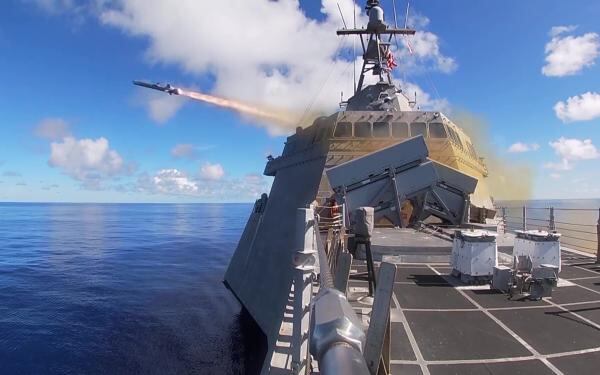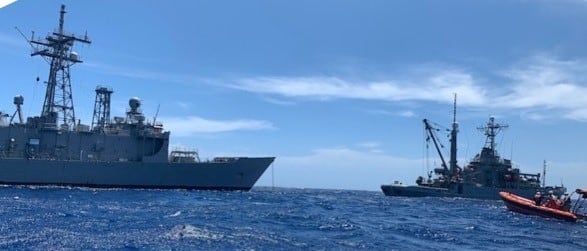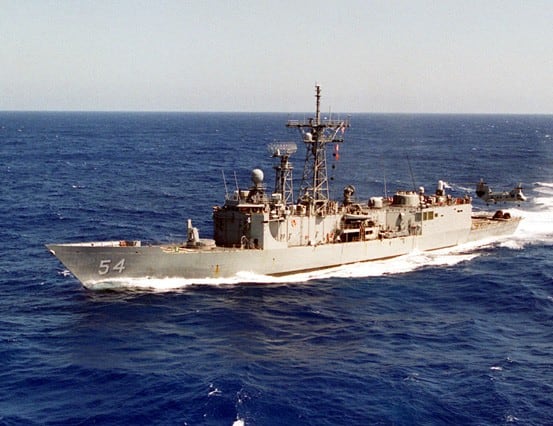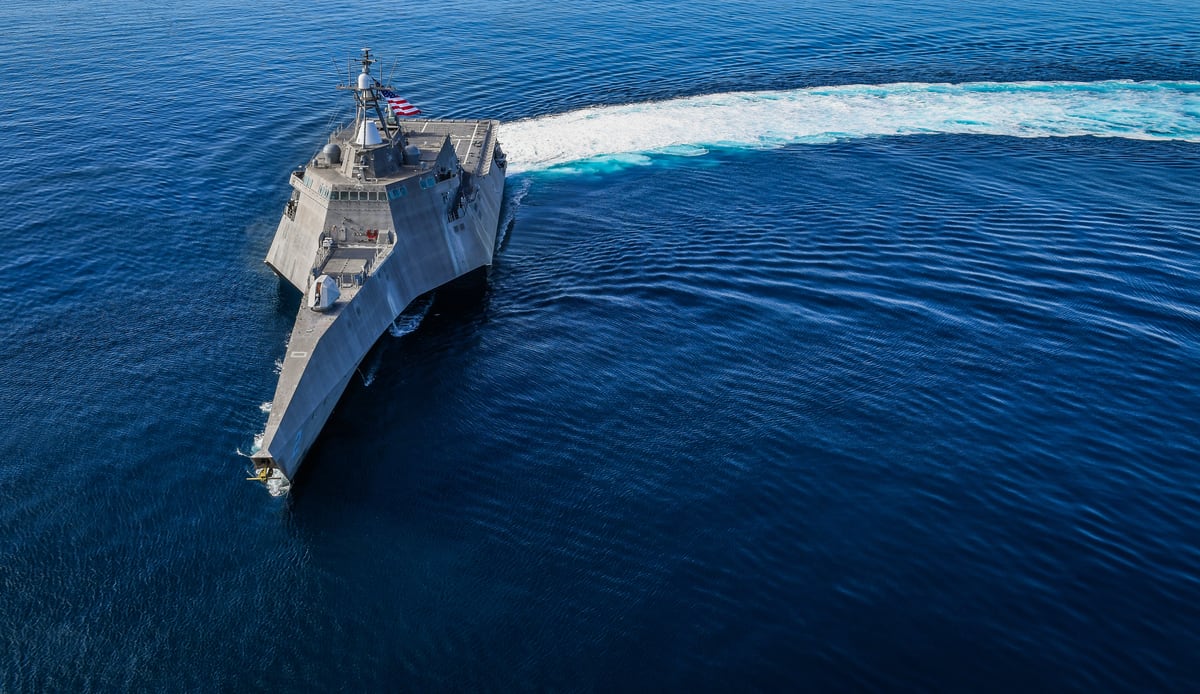It might take a village to raise a child but it took a Naval Strike Missile fired from a littoral combat ship and a barrage of rockets and bombs from three maritime patrol squadrons, Air Force B-52 Stratofortresses and two of Singapore’s warships to send the ex-frigate Ford more than a thousand fathoms deep.
Tuesday’s SINKEX of the Oliver Hazard Perry-class Ford gathered a formidable force 170 nautical miles off the coast of Guam, including the Air Force’s 69th Expeditionary Bomb Squadron, the Navy’s Maritime Patrol Squadrons 1, 5 and 47 and Singapore’s multi-role stealth frigates Formidable and Intrepid, which pounded the decommissioned vessel with Harpoon missiles.
AGM-114 Hellfire missiles from MH-60S Sea Hawks flown by Helicopter Sea Combat Squadron 25 also sliced and diced Ford.
But the highlight of the day might’ve been the debut of the Independence-variant littoral combat ship Gabrielle Giffords, which fired its new Raytheon/Kongsberg-made Naval Strike Missile, which can reach an enemy ship from more than 100 nautical miles away, skimming the sea at high subsonic speed while its electronic brain homes in on its target.
That’s about 30 nautical miles farther than the published range of the Harpoon and it’s so precise that sailors can pinpoint where it will spear into a vessel, such as blowing apart an engine room or decapitating a bridge.

Navy officials, however, did not release which munition actually sank the hulk.
And although they later disclosed that the Los Angeles-class fast attack submarine Key West was present during the Exercise Pacific Griffin 2019 event, they didn’t say if it delivered a torpedo deathblow to the former frigate.
“This exercise provided important opportunities for realistic at-sea training with live ordnance, conditions that cannot be duplicated otherwise,” said Capt. Matthew Jerbi, commodore of the Japan-based Destroyer Squadron 7 and co-commander of the Task Group for the exercise, in a prepared statement.
“Training alongside our Singapore partners in a complex exercise like this is invaluable.”

Although the date of the SINKEX in the Philippine Sea was a secret, Ford’s fate really wasn’t.
On Sept. 11, Military Sealift Command announced that its fleet ocean tug Sioux successfully transferred the hulk to its rescue salvage ship Grasp off the coast of Hawaii.
Sioux had towed it from Bremerton, Washington, where it had been stripped of environmental contaminants such as polychlorinated biphenyls (PCBs), transformers and capacitors, trash, mercury and petroleum products, leaving what officials called “nothing more than a shell" for Navy Sea Systems Command to certify for destruction off Guam.
“This isn’t something we do very often, but it is something we can do, if we have to,” said Michael Howell, Military Sealift Command Pacific’s Combat Logistics Force Tow and Salvage Ship scheduler, at the time.
“In this case, we couldn’t bring Sioux and the tow into Hawaii because of environmental concerns, so we had to go with the decision to transfer at sea."

The former frigate was named for Gunner’s Mate 2nd Class Patrick O. Ford, who posthumously received the Navy Cross for his heroism during the Vietnam War.
On June 21, 1968, Ford was Patrol River Boat 750′s aft machine-gunner along the upper My Tho River near the village of Cai Be.
After capturing an enemy sampan, PRB 750 and a sister boat were ambushed by Viet Cong guerrillas firing rockets and machine guns.
Six B-40 rockets killed Ford’s patrol leader and coxswain and set the boat ablaze. Ford fired back. Then, with his clothing still on fire, he assisted three wounded shipmates into the river and was the last man off 750.
A Viet Cong machine gun blast killed him when he entered the water, according to the Navy’s official history of the battle.
The frigate honoring his legacy was laid down by Todd Pacific Shipyards Corp., in San Pedro, California, on July 11, 1983, launched less than a year later and commissioned on June 29, 1985, in its homeport of Everett, Washington.
The Navy decommissioned Ford in 2013 after more than 28 years of service providing anti-air, anti-surface and anti-submarine protection for U.S. warships and merchant vessels.
RELATED





